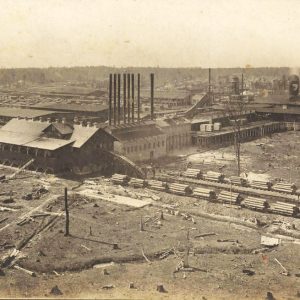calsfoundation@cals.org
Union Saw Mill Company
The Union Saw Mill company, based in Huttig (Union County), was the creation of experienced timbermen in St. Louis, Missouri, and Lufkin, Texas. The stockholders of the company first met in December 1902 in Little Rock (Pulaski County). Clarence Dean Johnson (1866–1940) of St. Louis was elected president and general manager, and Edwin Ambrose Frost (1869–1950) of Lufkin was elected vice president. The name of the company probably derived from the location of most of the timber: Union County, Arkansas, and Union Parish, Louisiana.
Union Saw Mill’s first pine mill began operating in 1904. The year before, the company had also begun construction on a town next to the mill site. The town was named after C. H. Huttig, one of the St. Louis investors. Within two years, Huttig had streets, water and electricity, schools, churches, a company store, a hotel, an icehouse, a meat market, and hundreds of houses. In time, a peach orchard, cotton gin, newspaper, company bank, community house, bowling alley, skating rink, and movie theater were added. Some of these additions were owned by outsiders, but all were sanctioned by the company. A hospital was constructed, and company employees were required to contribute to the Huttig Welfare Association, which paid for medical and dental services. Residential areas for Black and white workers were separated by a twenty-five-acre reservoir.
By 1910, a second pine mill had been added in Huttig. Fires struck the mills, most notably in May 1921 and October 1933, but a new sawmill opened in 1934. The company also operated a box factory in Huttig from the 1920s through the 1940s. Logs for the Huttig mill were harvested from thousands of acres of timberland the company purchased and also from independent contractors. At first, the company sold its land once the timber was harvested, but by the 1920s the Union Saw Mill was keeping cut-over land and managing it for future yield. The company leased some of its land for oil and gas exploration.
The Union Saw Mill used the Ouachita River and various railroad lines to move logs to the mill and lumber to markets. Rail connections northward—from nearby Felsenthal (Union County) into El Dorado (Union County)—were accounted for when the first mill was built. Union Saw Mill stockholders invested in the Little Rock and Monroe Railway Company in order to complete a forty-one-mile line south from Felsenthal to Monroe, Louisiana, to ship product to market. In 1905, the Union Saw Mill sold that line to the Missouri Pacific Railroad Company. The Union Saw Mill company created the Louisiana and Pine Bluff Railway to help move timber. The Louisiana and Pine Bluff Railway had its own locomotives, logging cars, and crews, and it built spur lines out into company forests.
Union Saw Mill workers organized in the 1930s and, by the 1940s, were represented by the United Brotherhood of Carpenters and Joiners of America, Local 2660. In time, contracts were negotiated by the United Brotherhood of Carpenters, Local 2346.
Frank W. Scott, who was born in 1877, was a major player in Union Saw Mill operations for more than three decades. He served first as secretary-treasurer, then vice president, and, beginning in 1931, president. Scott managed the construction of the railroads, the town, and the mills. He oversaw the entire operation until the late 1930s, when his health began to fail. Scott represented the company in various state organizations. He was elected president of the Associated Industries of Arkansas and the Arkansas State Chamber of Commerce, and he chaired the Arkansas Centennial Commission. He died in 1954.
C. D. Johnson left the company in 1918 and began investing in Oregon timber. In 1925, the Union Saw Mill became part of E. A. Frost’s Frost Lumber Industries of Shreveport, Louisiana. E. A. Frost died in 1950, and Frost Lumber Industries was sold in 1952 to Olin Industries of East Alton, Illinois. The sale included the Union Saw Mill, its railroad, and some 250,000 acres of timberland. Fred H. Wilson followed Scott as manager of Union Saw Mill and ran the company until it was sold to Olin Industries.
The Huttig sawmill was thoroughly overhauled by Olin in the 1950s, and a plywood mill was added in 1971. Huttig remained a company town until the 1950s when Olin Industries sold its town properties. Residents of nearby Felsenthal were fundamentally connected to Huttig and its institutions.
In 1974, Olin—which had become Olin Mathieson Chemical Corporation—spun off its wood products division headquartered in West Monroe, Louisiana. The division, called Olinkraft, included the Huttig sawmill. In 1979, Manville Corporation of Denver, Colorado, purchased Olinkraft and made it part of Manville Forest Products Corporation. The plywood mill operated until 1988. In 1991, the name was changed to Riverwood International Corporation. In 1996, Plum Creek Timber Company of Seattle, Washington, purchased Riverwood, and in 2000 Plum Creek sold the Huttig sawmill to West Fraser Timber Company of Vancouver, British Columbia, Canada. Plum Creek kept the timberland. In 2004, West Fraser completed a comprehensive modernization of the mill. In 2016, Plum Creek merged with Weyerhaeuser Company. In January 2024, West Fraser announced that the company would “indefinitely curtail” the operations its sawmill, citing low lumber commodity prices; about 140 workers were affected by the plan.
For additional information:
“Fine Mill Plants.” Pine Bluff Daily Graphic, September 27, 1903, p. 3.
Gettinger, Aaron. “Sawmill in Huttig Is Closing Operation.” Arkansas Democrat-Gazette, January 11, 2024, pp. 1D, 2D. Online at https://www.arkansasonline.com/news/2024/jan/11/sawmill-in-huttig-is-closing-operation/ (accessed January 11, 2024).
“Home Ownership Offered to Residents.” Huttig News, September 10, 1953, p. 1.
“Mill Workers to Return to Jobs.” Camden News, October 31, 1933, p. 4.
“State to Stop Loss in Ghost Mill Towns.” Hope Star, April 4, 1931, pp. 1, 3.
Union Saw Mill Materials. Special Collections, University of Arkansas Libraries, Fayetteville, Arkansas. Finding aid online at https://uark.as.atlas-sys.com/repositories/2/archival_objects/680845 (accessed August 30, 2023).
Bob Besom
Fayetteville, Arkansas
This entry is adapted with permission from the finding aid for the Union Saw Mill Materials at Special Collections, University of Arkansas Libraries.
 Business, Commerce, and Industry
Business, Commerce, and Industry Early Twentieth Century, 1901 through 1940
Early Twentieth Century, 1901 through 1940 Union Saw Mill
Union Saw Mill 




Comments
No comments on this entry yet.